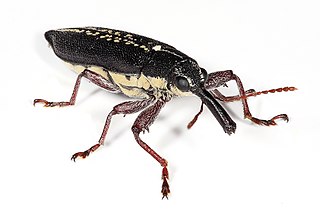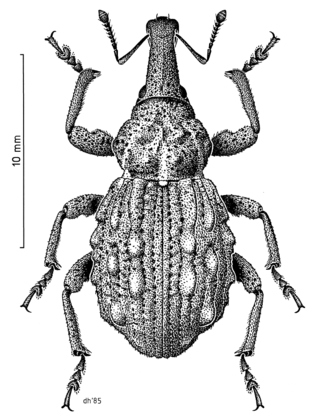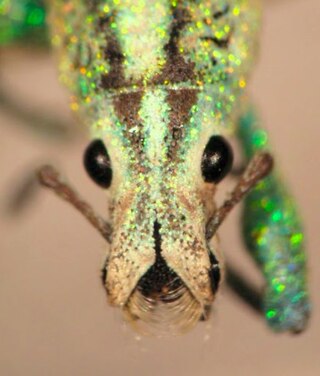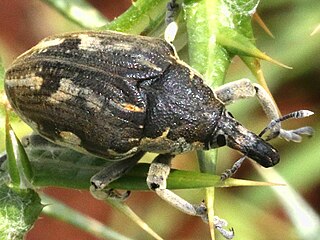Related Research Articles

The Curculionidae are a family of weevils, commonly called snout beetles or true weevils. They are one of the largest animal families with 6,800 genera and 83,000 species described worldwide. They are the sister group to the family Brentidae.

Weevils are beetles belonging to the superfamily Curculionoidea, known for their elongated snouts. They are usually small – less than 6 mm in length – and herbivorous. Approximately 97,000 species of weevils are known. They belong to several families, with most of them in the family Curculionidae. It also includes bark beetles, which while morphologically dissimilar to other weevils in lacking the distinctive snout, is a subfamily of Curculionidae. Some other beetles, although not closely related, bear the name "weevil", such as the biscuit weevil, which belongs to the family Ptinidae.

Echinops is a genus of about 120 species of flowering plants in the family Asteraceae, commonly known as globe thistles. They have spiny foliage and produce blue or white spherical flower heads. They are native to Europe, east to central Asia, and south to the mountains of tropical Africa. Globe thistle is the host plant of weevil Larinus vulpes.

Belidae is a family of weevils, called belids or primitive weevils because they have straight antennae, unlike the "true weevils" or Curculionidae which have geniculate (elbowed) antennae. They are sometimes known as "cycad weevils", but this properly refers to a few species from the genera Parallocorynus and Rhopalotria.

The palm weevil Rhynchophorus ferrugineus is one of two species of snout beetle known as the red palm weevil, Asian palm weevil or sago palm weevil. The adult beetles are relatively large, ranging between 2 and 4 centimetres long, and are usually a rusty red colour—but many colour variants exist and have often been classified as different species. Weevil larvae can excavate holes in the trunks of palm trees up to 1 metre (3.3 ft) long, thereby weakening and eventually killing the host plant. As a result, the weevil is considered a major pest in palm plantations, including the coconut palm, date palm and oil palm.

Hadramphus tuberculatus is a rare weevil endemic to Canterbury in the South Island of New Zealand. It was thought to be extinct in 1922 but was rediscovered in 2004,

Curculio nucum, the nut weevil, is a medium-sized beetle, with an especially elongated snout, characteristic of the Curculionini tribe of the weevil family (Curculionidae). Its larvae develop in hazel nuts Corylus avellana, being a serious pest in hazelnut orchards. It occurs in most of Europe, from south Sweden, Finland and Great Britain to the Mediterranean.

Anthonomus eugenii is known as the pepper weevil. This beetle feeds and lays eggs on plants in the genus Capsicum and a few species in the genus Solanum. A. eugenii is native to Mexico, however, it is an important pest of Capsicum in Florida, Puerto Rico, and Central America.

Larinus is a genus of true weevils, comprising about 180 species, mostly in the Palaearctic region with some species introduced to North America. Turkey appears to have a significant diversity of the group, with more than 50 species recorded in the eastern part of the country.
Larinus sibiricus is a species of true weevil found in Eastern Europe and the Middle East.
Larinus araxicola is a species of true weevil found in the Araks valley in northeastern Turkey.

Hylobius transversovittatus is a species of weevil in the family Curculionidae. It is native to the Old World where both adults and larvae feed on purple loosestrife. This plant is regarded as an invasive species in North America and the weevil has been introduced into both the United States and Canada in an effort to control the plant.

Sternochetus mangiferae is a weevil commonly known as the mango seed weevil, mango stone weevil, or mango weevil. It is a compact weevil typical of the Cryptorhynchinae. It was first described in 1775 in the genus Curculio. The adults are 7.5-9.5 mm long and 4 mm in width.

Apoderus coryli, common name hazel-leaf roller weevil, is a species of leaf-rolling beetles belonging to the family Attelabidae subfamily Attelabinae. Because of the trunk-like elongated head, it is often mistakenly attributed to the weevils.

Lixus fasciculatus is a species of weevils belonging to the family Curculionidae.

Larinus turbinatus is a species of true weevil in the family of beetles known as Curculionidae.
Xylosandrus discolor, is a species of weevil found in Australia, Micronesia, Myanmar, China, India, Sri Lanka, Indonesia, Malaysia, Taiwan and Thailand.

Larinus sturnus is a species of cylindrical weevils belonging to the family Curculionidae, subfamily Lixinae.

Oxyderces is a genus of broad-nosed weevils in the family Curculionidae distributed in South America. It can be recognized by the presence of dense setae on the apex of the rostrum and postocular setae.

Larinus onopordi, also known as the globe thistle capitulum weevil, is a species of true weevil in the genus Larinus.
References
- 1 2 Biolob
- 1 2 Fauna Europaea
- ↑ Ukrainian Biodiversity Information Network
- ↑ Levent Gültekin & Miguel Angel Alonso-Zarazaga A review of the Palaearctic species of Larinus Dejean (Coleoptera: Curculionidae) in C. J. Schoenherr collection: nomenclature and lectotype designations June 2015 Journal of Insect Biodiversity 3(9):1-26 - DOI:10.12976/jib/2015.3.9
- ↑ Gosik, Rafał, Skuhrovec, Jiří (2011): Descriptions of mature larvae and pupae of the genus Larinus (Coleoptera: Curculionidae, Lixinae). Zootaxa 3019: 1-25, DOI: 10.5281/zenodo.278666
- ↑ iNatutalist
- ↑ Plant parasites in Europe